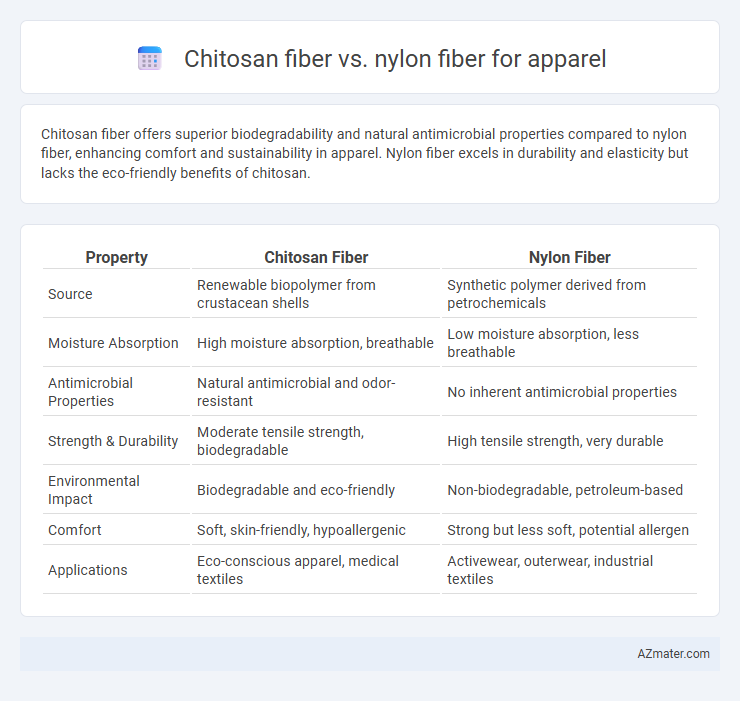Chitosan fiber offers superior biodegradability and natural antimicrobial properties compared to nylon fiber, enhancing comfort and sustainability in apparel. Nylon fiber excels in durability and elasticity but lacks the eco-friendly benefits of chitosan.
Table of Comparison
| Property | Chitosan Fiber | Nylon Fiber |
|---|---|---|
| Source | Renewable biopolymer from crustacean shells | Synthetic polymer derived from petrochemicals |
| Moisture Absorption | High moisture absorption, breathable | Low moisture absorption, less breathable |
| Antimicrobial Properties | Natural antimicrobial and odor-resistant | No inherent antimicrobial properties |
| Strength & Durability | Moderate tensile strength, biodegradable | High tensile strength, very durable |
| Environmental Impact | Biodegradable and eco-friendly | Non-biodegradable, petroleum-based |
| Comfort | Soft, skin-friendly, hypoallergenic | Strong but less soft, potential allergen |
| Applications | Eco-conscious apparel, medical textiles | Activewear, outerwear, industrial textiles |
Introduction to Chitosan and Nylon Fibers
Chitosan fiber, derived from chitin found in crustacean shells, offers biodegradability, antimicrobial properties, and excellent moisture absorption, making it ideal for eco-friendly and functional apparel. Nylon fiber, a synthetic polyamide known for high tensile strength, durability, and elasticity, dominates the apparel market due to its lightweight and quick-drying characteristics. Comparing chitosan and nylon fibers highlights key differences in sustainability, performance, and skin-friendliness for various clothing applications.
Origin and Production Methods
Chitosan fiber is derived from chitin, a natural polymer extracted primarily from crustacean shells through deacetylation, emphasizing eco-friendly and biodegradable production. Nylon fiber, a synthetic polymer created via polycondensation of hexamethylenediamine and adipic acid, involves energy-intensive chemical processes in petrochemical refineries. The distinct origins highlight chitosan as a renewable bio-based textile, while nylon remains petroleum-dependent with large-scale industrial production.
Fiber Structure and Chemical Composition
Chitosan fiber is a biopolymer derived from chitin, characterized by its amino groups and a partially crystalline structure that offers biodegradability and inherent antimicrobial properties. Nylon fiber consists of synthetic polyamides with repeating units containing amide linkages, exhibiting high tensile strength, elasticity, and chemical resistance due to its crystalline and amorphous regions. The natural polymer structure of chitosan results in moisture absorption and odor control, while nylon's synthetic polyamide structure provides durability and wrinkle resistance in apparel applications.
Mechanical Properties: Strength and Durability
Chitosan fiber exhibits superior tensile strength and excellent abrasion resistance, making it highly durable for apparel applications compared to nylon fiber. While nylon offers high elasticity and resilience, chitosan's antimicrobial properties enhance fabric longevity by reducing microbial degradation. The combination of mechanical robustness and natural bioactivity positions chitosan fiber as an innovative alternative to conventional nylon in sustainable textile manufacturing.
Moisture Absorption and Comfort
Chitosan fiber exhibits superior moisture absorption compared to nylon fiber due to its hydrophilic nature derived from chitin, enabling efficient sweat management and enhanced breathability in apparel. This natural fiber's antibacterial properties contribute to improved comfort by reducing odor and skin irritation, which are common issues with synthetic nylon textiles. Nylon fiber, while durable and lightweight, tends to retain moisture on the skin, leading to reduced comfort and potential chafing during prolonged wear.
Antibacterial and Hypoallergenic Features
Chitosan fiber exhibits superior antibacterial properties due to its natural ability to inhibit bacterial growth, making it ideal for apparel aimed at reducing odor and skin infections. Its hypoallergenic nature stems from biocompatibility and moisture regulation, reducing skin irritation commonly caused by synthetic fibers like nylon. Nylon fiber, while strong and durable, lacks inherent antibacterial qualities and may cause allergic reactions in sensitive skin, making chitosan fiber a preferred choice for health-conscious apparel applications.
Environmental Impact and Sustainability
Chitosan fiber, derived from natural sources like crustacean shells, offers superior biodegradability and lower environmental impact compared to petroleum-based nylon fiber, which is non-biodegradable and contributes to microplastic pollution. The production of chitosan fiber involves renewable resources and generates less greenhouse gas emissions, enhancing its sustainability profile relative to nylon. Nylon's energy-intensive manufacturing and reliance on fossil fuels contrast with chitosan fiber's eco-friendly attributes, making it a preferable choice for sustainable apparel manufacturing.
Dyeability and Color Fastness
Chitosan fiber exhibits superior dyeability compared to nylon fiber due to its natural amino groups, which allow for enhanced absorption of reactive and acid dyes, resulting in vibrant, long-lasting colors. Nylon fibers, while capable of achieving bright colors, often require specific dyeing processes like acid dyeing, which might yield lower colorfastness under prolonged exposure to light and washing. Chitosan fibers also demonstrate better color fastness properties, including resistance to fading and bleeding, making them preferable for durable, eco-friendly apparel applications.
Cost Implications for Apparel Manufacturing
Chitosan fiber, derived from natural chitin sources such as crustacean shells, often incurs higher raw material and processing costs compared to petroleum-based nylon fiber, impacting overall apparel manufacturing expenses. Nylon fiber offers cost-efficiency due to well-established production infrastructure and economies of scale, making it a preferred choice for large-volume apparel manufacturing. However, the biodegradability and antimicrobial properties of chitosan fiber present value-added features that could justify its premium price in sustainable and high-performance apparel markets.
Future Prospects in Apparel Industry
Chitosan fiber holds significant promise in the apparel industry due to its natural biodegradability, antibacterial properties, and eco-friendly production process, positioning it as a sustainable alternative to traditional nylon fibers. Innovations in blending chitosan with other fibers can enhance fabric performance, durability, and comfort while reducing the environmental footprint associated with synthetic fibers like nylon. Growing consumer demand for sustainable and functional textiles drives further research and commercialization of chitosan fibers, indicating strong future adoption in eco-conscious fashion markets.

Infographic: Chitosan fiber vs Nylon fiber for Apparel
 azmater.com
azmater.com